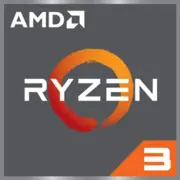AMD Ryzen 3 3200U

AMD Ryzen 3 3200U: Budget Processor for Everyday Tasks
April 2025
Introduction
The AMD Ryzen 3 3200U processor, released in 2019, remains a popular choice for budget laptops. Even in 2025, with a market filled with more modern chips, devices like the Lenovo Ideapad 3 and HP 14 continue to be sold for $300–400. In this article, we will explore who this CPU is suitable for, its strengths and weaknesses, and whether it is worth considering in the era of 3nm technology.
Architecture and Manufacturing Process: Zen+ and Vega 3
CPU Features
The Ryzen 3 3200U is built on the Zen+ microarchitecture (codename Picasso) with a 14nm manufacturing process. It features:
- 2 cores and 4 threads thanks to Simultaneous Multithreading (SMT).
- A base clock speed of 2.6 GHz and a maximum Turbo Boost speed of 3.5 GHz.
- 4 MB of L3 cache, which improves responsiveness during multitasking.
While 14nm is an outdated standard (new AMD chips use 5–6nm), Zen+ provides adequate energy efficiency for basic tasks.
Integrated Graphics
The integrated Radeon Vega 3 graphics include:
- 192 shader processors and a clock frequency of up to 1200 MHz.
- Support for DirectX 12, Vulkan, and FreeSync technology for smooth visuals.
- Capability to output 4K displays via HDMI 2.0.
Vega 3 is weaker than the current RDNA 2/3, but it handles less demanding games and video processing at resolutions up to 1080p.
Power Consumption and TDP: Balance Between Power and Battery Life
The CPU's TDP is 15W, which is typical for mobile U-series CPUs. This allows for:
- Use of passive or compact active cooling.
- Installation of the chip in thin laptops (ultrabooks) weighing from 1.5 kg.
- Maintaining low temperatures (up to 60–70°C under load).
To optimize power consumption, AMD employs:
- SenseMI — adaptive frequency and voltage management.
- Cool’n’Quiet — reducing power consumption in idle mode.
Performance: What Can Ryzen 3 3200U Achieve in 2025?
Office and Multimedia
- Office tasks: Working with documents, browsing (10+ tabs), video calls on Zoom — without lag.
- Multimedia: Streaming 1080p video (Netflix, YouTube), basic editing in Shotcut/CapCut.
- Geekbench 6: 777 (single-thread), 1487 (multi-thread). For comparison, the Intel Core i3-10110U scores around ~800/1600.
Gaming
Settings at 720p/low:
- CS:GO — 40–50 FPS.
- Dota 2 — 35–45 FPS.
- GTA V — 25–30 FPS.
Modern AAA titles (Cyberpunk 2077, Starfield) are not suitable for this CPU.
Turbo Boost Mode
Under load, the frequency rises to 3.5 GHz, but only for a short duration (1–2 minutes). Afterward, it stabilizes around ~3.0 GHz. Proper cooling is essential for stable performance.
Use Cases: Who is this Processor Suitable For?
- Students: Working with texts, presentations, online courses.
- Office workers: Email, Excel, CRM systems.
- Home users: Web surfing, streaming, light gaming.
Not suitable for:
- Gamers (except for cloud gaming).
- Designers and video editors.
Battery Life: How Long Will the Laptop Last?
With a battery capacity of 40–50 Wh, the runtime will be:
- 8–10 hours under minimal load (reading, office tasks).
- 4–5 hours during active use (YouTube, multitasking).
Tips for extending battery life:
- Enable "Battery Saver" mode in Windows.
- Reduce screen brightness to 50–70%.
- Disable background applications.
Comparison with Competitors
AMD Ryzen 3 3250U
A direct counterpart with slightly higher clock speeds (2.6–3.5 GHz). The performance difference is less than 5%.
Intel Core i3-10110U
- Advantages: Better single-thread performance (+7%).
- Disadvantages: Only 2 cores without Hyper-Threading.
Apple M1 (in base MacBook Air)
- The M1 outperforms the Ryzen 3 3200U by 2–3 times across all parameters, but the MacBook Air 2025 starts at $999.
Pros and Cons
Pros:
- Low price of laptops ($300–400).
- Multithreading support (4 threads).
- Sufficient performance for everyday tasks.
Cons:
- Outdated 14nm manufacturing process.
- Weak iGPU for modern gaming.
- Limited future-proofing (Windows 12 may require more resources).
Recommendations for Laptop Selection
- Device type: Ultrabook or budget laptop.
- Minimum specifications:
- 8GB of RAM (preferably 16 GB for multitasking).
- SSD of 256GB (not HDD!).
- IPS display with a resolution of 1920×1080.
- Avoid: Laptops with 4GB of RAM or TN displays.
2025 model examples:
- Lenovo IdeaPad 3 15ADA05 ($329).
- HP 14-dk1000 ($349).
Final Conclusion
The AMD Ryzen 3 3200U is a solid choice for those looking for an affordable laptop for basic tasks. Its key advantages are:
- Affordable price.
- Energy efficiency and quiet operation.
- Support for light gaming and multitasking.
However, in 2025, this processor should be viewed only as a temporary solution. If the budget allows, it’s better to consider laptops with Ryzen 5 5500U or Intel Core i5-1235U — they will last longer and handle more complex tasks.
Conclusion: The Ryzen 3 3200U is a proven option for study and work, but in the era of AI applications and 4K content, its capabilities are nearing their limit.
Basic
CPU Specifications
Memory Specifications
GPU Specifications
Miscellaneous
Benchmarks
Compared to Other CPU
Share in social media
Or Link To Us
<a href="https://cputronic.com/en/cpu/amd-ryzen-3-3200u" target="_blank">AMD Ryzen 3 3200U</a>